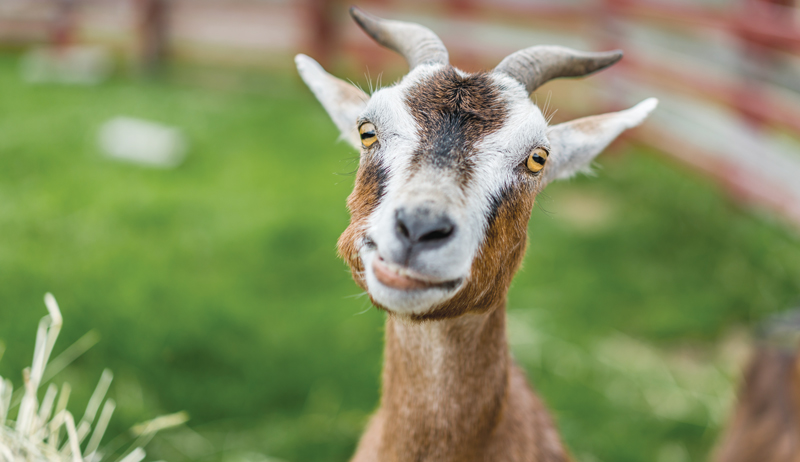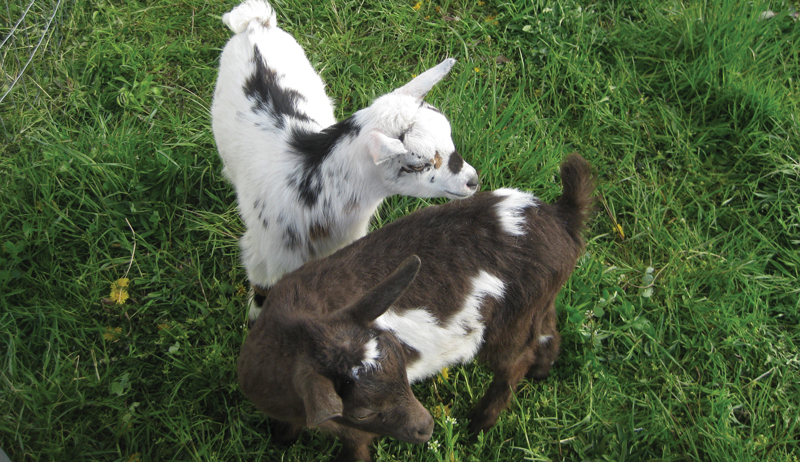
One need look no further than viral videos to realize that goats are pretty cute and really popular. In fact, more than one stranger has squealed with delight upon learning through some random conversation that I have goats.
But as with most living creatures, you shouldn’t buy goats just because they’re cute, especially if you live in an urban area where space is often limited. If you purchase baby goats, you could be looking at a 15-year commitment, so it’s a decision to take seriously.
What’s more, urban goats have their own set of challenges. Here are 10 questions to ask before deciding whether to purchase goats.
Does the Zoning in Your Area Allow Goats?
Check with your city or county planning department to get the answer to this question.
It might not be obvious. People are often surprised that their big city allows urban goats. Meanwhile a subdivision with half-acre yards and horses as neighbors might not allow what they define as “farm animals.”
Why keep goats? Well, goat yoga is one good reason.
What Do Your Neighbors Think of Goats?
Equally important as the zoning question is how your neighbors feel about you having goats.
Glenna Bowman of Vancouver, Washington, says that you should be educated about goats before talking to your neighbors. this way, you can give them accurate information as well as fun facts about goats.
If you get dairy goats, she suggests sharing ice cream and other dairy products that you make with the goats’ milk.
Why Do You Want Goats?
Like many domesticated animals, goats make great pets. But they do have special needs.
Unless you have at least an acre or two, you should probably stick with dogs or cats if you merely want pets. Goats make great pets with benefits, so if your goal is fiber or milk, goats might be a good fit for an urban dweller.
Angora goats, which produce mohair, and Nigerian dwarf goats, which are a small dairy goat, are especially good choices for smaller spaces. Bowman keeps Nigerian dwarf goats because she wanted dairy products, and NDs are the smallest dairy goat.
Smaller goats eat and poop less, so they’re easier to have in smaller spaces.
Can You Handle a Pair?
Goats are herd animals, which means they need at least one goat friend. Single goats get lonely and cry out for friends, which won’t make you terribly popular with your neighbors.
They also become excellent escape artists because they will go looking for a friend if they have none. Through the years I’ve been contacted by people desperate to find a companion for the single goat they purchased. They report that it wants to stay on their front porch all the time (and is pooping there, of course), or it tap-dances on top of their car. (Goat hooves are not easy on the paint.)
So be sure you have the time, space and money to get at least two.
How Much Time Do You Have for Them?
Speaking of time: If you want goats for milk, you need to milk them. It takes some time to learn to milk goats. Once you get good at it, though, it should not take more than 5 minutes to milk one.
In addition to that, you need to provide hay and fresh water for the goats twice daily. If the goats are in a moveable pen, it takes 10 minutes or so each day you move it.
You should trim hooves every one to three months, depending upon how fast the hooves grow on each goat.
If you get fiber goats, such as angoras, which produce mohair, they will need to be sheared twice a year. Although a professional can do this within a few minutes, it takes a novice 45 minutes or more.
Here are 7 creative uses for milk from your dairy goats.
How Much Space Do You Have?
Speaking of space: You can’t simply let your goats run around your urban backyard.
They’ll eat your roses and daylilies and bushes because they are browsers rather than grazers. Grass is at the bottom of their list of preferred foods.
To get goats, you must decide how much of your yard you are willing to give to the goats. If you have only two or three small-breed goats and a small yard, you could create a dry lot for them that is at least 30 by 20 feet, but you should put gravel in it as soon as they eat or kill all the grass.
Grass might not be their favorite food, but they’ll eat it if it’s the only green thing available to them. Without gravel in the pen when the grass is gone, the area becomes a muddy mess when it rains.
If you have an acre or more, you could create a movable pen with four livestock panels connected at the corners with carabiners (at least two per corner). Move it every two or three days so that the goats are always on fresh grass.
How Will You Feed Them?
If you live in the city and have to create a dry lot for your goat pen, you must bring in 100 percent of their feed. You will buy a lot of hay.
The price varies from $5 to $20 per bale, depending upon where in the U.S. you live. Only goats producing milk need grain, which can be purchased at farm-supply stores.
Although you can give them tree trimmings, it won’t really reduce your feed bill unless you own a tree-trimming service and can feed them large quantities daily.
Where Will They Sleep & Play?
The answer can’t be “in your house.”
When my daughter was young, she loved bringing the baby goats into the house. None lasted more than a month. Some were evicted within a week.
That’s when they started jumping on top of everything (including the DVD player) and chewing everything (such as electrical cords and mail). In fact, my daughter imagined that she might someday have to tell her teacher that her goat honestly ate her homework.
Also, goats can’t be completely housetrained like dogs or cats. Although my daughter successfully taught most of the goats to pee on a towel on the floor, they had trouble distinguishing a towel from a bathrobe or a rug. And when it came to pooping, they just let it drop whenever and wherever the urge hit.
Goats need their own housing that can have a layer of straw or wood shavings on the floor to soak up urine. Although the housing needn’t be insulated, even in cold climates, it should not be drafty.
Many people convert a deserted tool shed or playhouse into a goat shelter. Two smaller goats, such as Nigerian dwarves, would need at least 50 square feet. Standard size would need twice that much for a shelter that they’ll use only for sleeping and protection from bad weather.
In addition to a shelter, they need room to run around outside so they get plenty of fresh air and sunshine.
Most respiratory conditions are caused by goats being locked inside small spaces. Ammonia levels caused by urine and manure build up to dangerous levels before the human nose can sense anything, which is why goats need to spend lots of time outside.
Good air circulation in goats’ housing is important.
Check out these 6 tips to improve air circulation in livestock barns.
What Is Your Poop Plan?
You can’t just put goat manure in the garbage like you can cat waste and litter because it’s mixed with bedding. If you have a large garden, you can put the manure and bedding into a compost pile, which you can then use to feed your plants.
However, you need to have a plan B in case you wind up with more manure than you can use.
Eric Staswick’s family in Chicago had goats for four years before deciding they couldn’t keep them any longer. “Manure disposal was our biggest problem,” he says.
“We had plenty of folks who wanted [goat manure] for urban gardens and such but no one who wanted to come get it. I would rent a pickup and take a load to the local community garden every three to four months. But it just got to be a lot of hassle.
“We also had to have hay and straw brought in to the city a couple times a year. We stored it in our crawlspace, and actually that probably provided some insulation, but it was quite expensive…. Without having the space to pasture the goats, the economics of it just didn’t work out.”
Is There a Goat Vet Nearby?
Very few vets will see goats (which surprises a lot of people). And it’s a bad idea to try and persuade your dog’s vet to see your goats. Dogs and goats are very different animals.
“The most important thing is to find a good goat vet before bringing [goats] home, and establish a relationship before there is any kind of emergency,” Bowman says.
Goats are not difficult to care for, but they do have very specific needs. However, with a little education and planning, you can provide goats with a great home in an urban environment and provide everything they need.
This article appeared in Hobby Farm‘s Urban Farm 2019 annual, a specialty publication produced by the editors and writers of Hobby Farms magazine. You can purchase this volume, Hobby Farms back issues as well as special editions such asBest of Hobby Farms and Living off the Grid by following this link.




